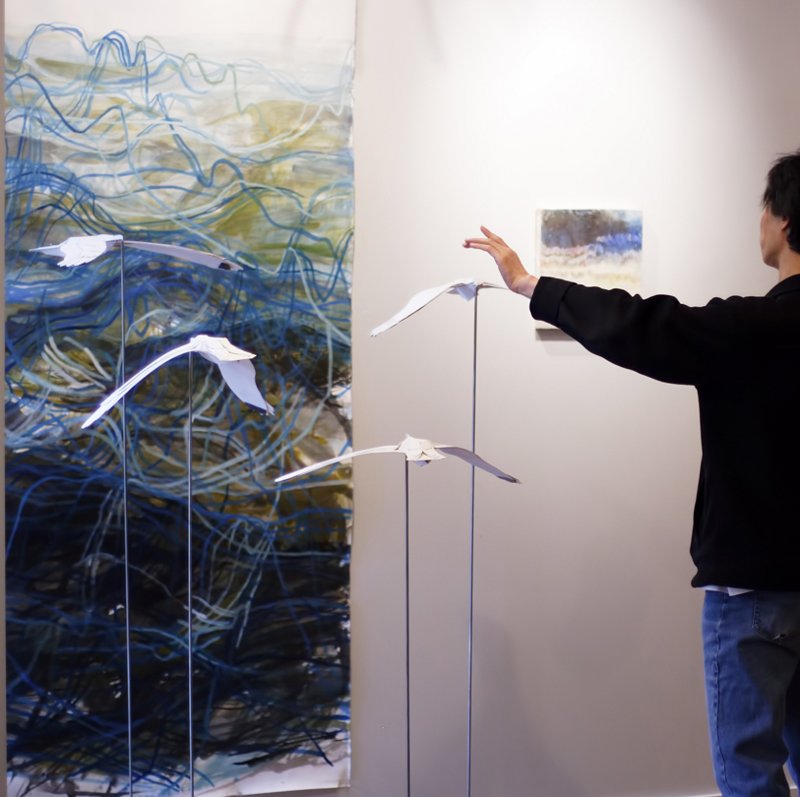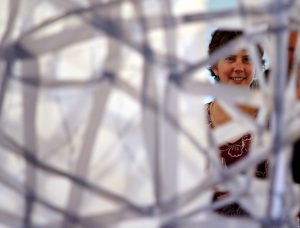Living Data
Exchange
The experiential process of observation and reflection is key to art and science
and is an essential component in understanding interdependence
of all species and ecosystems, terrestrial and aquatic.
Paul Fletcher Animator
Disclaimers, Copyrights and Citations Facebook Community COMMENTS
ART FROM CLIMATE SCIENCE
Living Data Program for the 2013 Ultimo Science Festival, Sydney, September 12-21.
Hitch Hikers Objects by Leanne Thompson
Many people view the world as a consumable resource. Art is made to break away from that to see our selves as part of what we are destroying.

Leanne Thompson. (left to right) Pelagic 2012. Charcoal, acrylic, ink and gouache on rag paper. 2310 x 1080mm. Remote Foragers 2012. Paper, reclaimed plastic, lead, steel 4 elements each 1000 to 1700 x 600 x 400mm / total area approx. 1700 x 1300 x 1000mm (flexible)
Things that are outside of our field of vision don't enter our consciousness, especially not at the checkout.
Remote Foragers arose from dialogue with Dr Denise Hardesty from the CSIRO. She studies the Flesh-footed Shearwater, a magnificent pelagic bird, living on the open sea and returning to Lord Howe Island to breed. Her field work shows that more than 75 per cent of the birds they examine (via autopsy) have guts full of plastic. Other studies show this species as the most contaminated bird on the planet, this creature that lives in the remotest and supposedly 'cleanest' areas of the world. Dr Harnesty is reticent to make conclusions as to the dangers faced by this relatively common bird as there is a lack of historical data to compare with her findings. However, the obvious conclusion we can draw concerns the ubiquitous reach humanity. Contamination is found even in these remote locations. Things that are outside of our field of vision, they don't enter our consciousness - especially not at the checkout. The work plays with the notion of balance and extinction. Like toys or novelties they perch on their beaks alone. And though we may find the 'balancing act' amusing it highlights that their instinctual feeding habits are precariously disrupted by plastic detritus. The work on paper 'Pelagic' behind gives context to the environment and although appearing pristine these remote locations have concentrations of toxins within the food web.

Leanne Thompson
Just over ten years ago I discovered the work of Lyn Margulis. An evolutionary biologist with radical ideas ahead of her time, but determined to take on the orthodoxy of science and convince them to embrace the truth she uncovered. She discovered that symbiotic mergers were the basis of evolution and that this created entire new paradigms for describing life – from microscopic cells, through to a self-regulating planetary ecosystem and on to cultural narratives that define human interactions. These ideas resonated deeply with me, in my artwork and as a living being totally embedded in a complex and interdependent environment. I was excited to embrace 'working together' instead of competition in all facets of my life.
Like individual cells we are capable of changing perception, societal inertia and the impact of humanity on a macro scale. I believe that mindful, small actions by individuals are profound. These small movements, accumulated over hundreds of years of scientific enquiry, are gathering momentum as the urgency of climate change issues press in and we see the glimmer of understanding the entirety of the system. It explains the current interest in inter-disciplinary collaborations and dialogues and art is a perfect vehicle to make 'visible' the connections.
The artwork I make utilizes many materials and methods - printmedia, painting, work on paper, sculpture and installation. Many of the pieces are concerned with engaging the public, shifting awareness through participation. It is also a strong belief that creativity is a human trait and the more everyone is encouraged to be creative, the quicker we will stop valuing a mass-produced lifestyle. My recent work aims to make visible the impacts of our lifestyle on the big picture.
I have been reading papers and approaching various scientists whose research covers areas I wish to understand. Initially, interest in marine debris and bio-accumulation took me on a journey through Cronulla Fisheries and Sydney Water to Dr Denise Hardesty at CSIRO with her research on Shearwater population at Lord Howe Island, the work of Ghost Nets Australia and Kylie Higgins at DAFF in relation to quarantine risks posed by exotic species floating on plastics in the ocean. From this I became aware of microscopic plastic contamination at the bottom of the food chain in phytoplankton, how this mutates and contaminates and then concentrates toxicity in all predators above. This biomass of microscopic life is diminishing resulting in a reduction of oxygen released into the atmosphere. My current investigations have moved away from the oceans, inland to NSW Central Tablelands water catchments and land use and I am looking forward to working with Prof David Goldney, an ecologist from CSU about ‘Landsmanship’, our connection to elements we call resources and how we as a society allocate value to them and how to disengage development and growth from sustainability.











